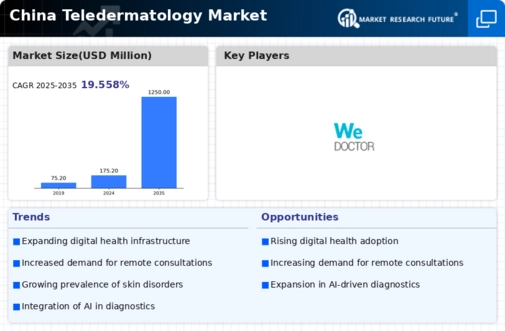The competitive insights of the China Teledermatology Market reveal a rapidly evolving landscape driven by technological advancements, increasing demand for accessible healthcare, and the growing emphasis on efficient patient-provider communication. This market is characterized by a multitude of players focusing on providing innovative telehealth solutions tailored for dermatological consultations, leading to heightened competition. In particular, the integration of artificial intelligence and mobile applications into healthcare services has transformed the way dermatological care is delivered, fostering a more patient-centric approach.
The surge in smartphone penetration and internet connectivity across China has further propelled the adoption of teledermatology services, positioning the market for substantial growth in the coming years as stakeholders, including healthcare providers, technology firms, and government regulatory bodies, collaborate to enhance service delivery and accessibility.WeDoctor holds a prominent position within the China Teledermatology Market, leveraging its extensive network of healthcare professionals and advanced technological infrastructure. The platform has distinguished itself through its user-friendly interface, allowing patients to easily seek dermatology consultations remotely.
WeDoctor benefits from its strong brand recognition and partnerships with numerous hospitals and clinics, which enhance its credibility and operational capacity.
The company’s commitment to improving patient outcomes by providing timely advice and digital access to dermatological expertise has fostered widespread acceptance among consumers. Additionally, WeDoctor's focus on continuous innovation and data-driven approaches ensures it remains competitive in an industry that is increasingly characterized by rapid technological changes.Lenovo Health also plays a significant role in the China Teledermatology Market by offering tailored healthcare solutions aimed at enhancing patient care. The company integrates its technological prowess, particularly in hardware and software development, to provide platforms that bridge the gap between patients and dermatology specialists.
Lenovo Health's product offerings include teleconsultation tools, AI-driven diagnostic solutions, and integrated healthcare management systems that help streamline dermatological care. The company has successfully established partnerships and collaborations with healthcare providers to enhance its market presence and expand service offerings. Lenovo Health's strengths lie in its robust research and development capabilities, allowing it to innovate continuously. Through strategic mergers and acquisitions, it has bolstered its portfolio, combining strengths in technology and healthcare to optimize patient interactions in the dermatology sector across China.


